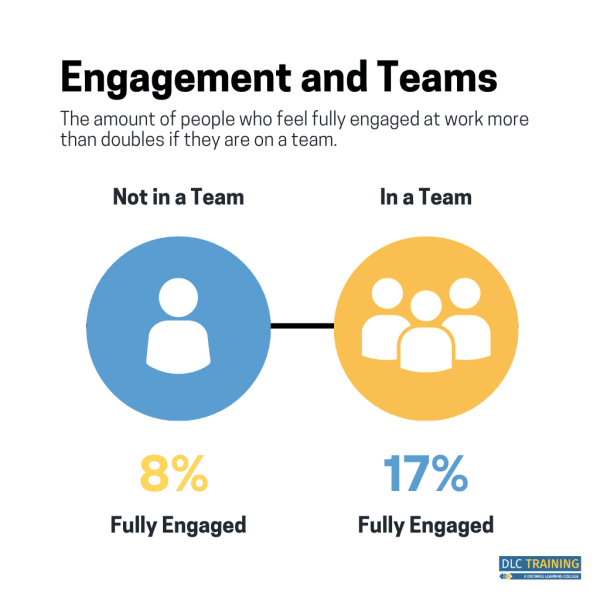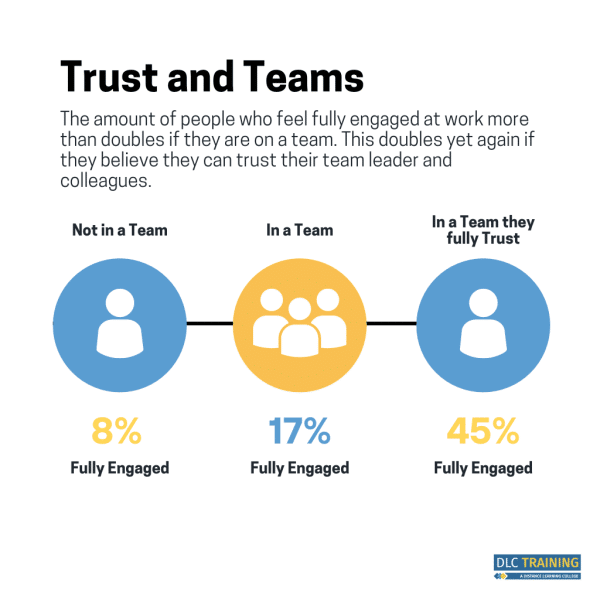An ADPRI study outlines the importance of engagement at work, and shows that around 16% of employees feel engaged in their job, whereas 84% don’t and are simply “coming to work”. This has a huge knock-on effect concerning efficiency, success, and general well-being in the workplace, but how is it affected by teamwork?

The Different Types of Engagement:
A case study from the Harvard Business Review details the difference between two nurses at work. One works in a hospital that applies an “interdisciplinary approach” to their patients, where the care plan for each patient is planned by and worked towards by a combination of a case manager, physician, physical therapist, occupational therapist, social worker, the nurse, and the patients family.
The other nurse in the study works in a more traditional shift pattern where two administrators oversee 76 nurses, with each of them rotating in and out of different shifts and patients.
The conclusion is that the nurse with more input, decisions and support can truly care for and engage with not just their patients, but their colleagues and job as a whole. The other nurse, who is moved in and out of wards, to different patients, and just follows a care plan set by others enjoys and engages with their job much less.
For lots of people seeing this difference will bring several conclusions along the lines of, “Of course having more input engages you more”, or “different things work for different people, so maybe the second nurse should change their job”.
And although those ideas aren’t completely invalid, the hidden strength in the first nurse’s engagement isn’t just the way they work, it is the team they do it with.

This leads to the wider point of just working with others, which as we all know isn’t always the best experience. But that isn’t what we are discussing here, instead, it’s a team that is engaged with and because of each other.
A team that shows up each day, can discuss and collaborate with purpose, not just meeting regularly for the sake of keeping each other updated but otherwise working independently. In a world of Zoom calls and remote working, we all know the thought of “this doesn’t need to be a meeting” all too well.
What people need to properly work within and engage with a team is to be able to trust their colleagues. Trusting them to do their best, trusting their expertise and allowing each other to help when or step back whenever needed.
Trusting Your Team

The statistics show that just working within a team isn’t enough, it’s trust and engagement within that team that are key, but how can that be measured and improved?
In the Harvard study, two key phrases were asked, and the most engaged employees agreed with them; “I have the chance to use my strengths every day at work” and “At work, I clearly understand what is expected of me”.
This shows that in the best teams, colleagues feel useful, helpful, helped, and understood.
These qualities aren’t achieved overnight and often involve time and dedication, but it essentially comes down to communication and conversation.
In the example of the two nurses, one nurse is one of 76 managed by two people with little to no time talking to their team leader or have real input in what they are doing. In the other example, the nurse has regular meetings with various team members (each of whom is also meeting with each other) allowing a regular stream of updates and better care, but also more effective communication and engagement.
Overall ideas of team engagement and things like workplace culture can easily become a bit blurred – regular meetings or check-ins can quickly become useless if everyone isn’t fully engaged and communicating properly.
In that case, the meetings become a part of the culture and routine, with little to no practical input towards fully engaged employees, efficiency or success. But the data shows that specifically working within a team, not just occasionally working with other people improves engagement and effectiveness, especially if you trust the team around you.
For more information on effective teams and the types of engagement, take a look at our DLC Training Focus resource on Employee Engagement.